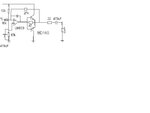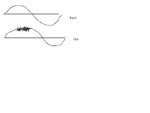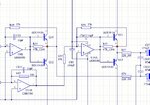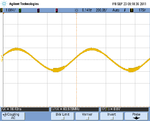userx2
Full Member level 3

Hello all.
Hope this is the right forum. I am a desing engineer (mostly digital) and I have a problem with an audio circuitthat I kinda designed.
I have a bridge amplifier using BD139-16 and BD140-16 (see simplified rough pic).
It's part of a bigger system and we have made 50 of these. They were all kinda fine when testing the distortion with an AP (audio processor).
Now, another larger batch was made and ALL of them have huge distortion when testing on the AP.
I looked into it today with a signal generator and oscilloscope and I found that the output stage (Headset load = ~100 Ohm) seems to burst into a VERY (YES VERY)!! high fequency oscillation at a certain level and fequency of input. I have attached a rough sketch of what I get on the scope. The osillation is visible in the top half of the output waveform.
I have tried everything I can think of and so has my collegue. We are not able to solve it at this stage and we are desperate.
The oscillation frequency is actually 69.65MHz (!!!!!!!)
It all ocuurs suddenly when the sine peak reaches around ~1V.
Removing the BD140 transitor solves the problem but then of course, I can't drive the full voltage swing required.
Removing the BD139 makes not much difference.
Touching anything (the op am poutput etc) with a 10:1 scope probe, changes the output waveform and it changes the level at which the oscillations occurs.
Lowering the 47 R resistor by adding a 120R in parallel, stops the problem but again, does not allow for the full voltage swing, if lower impedance loads are used.
We have tried caps across the 27k, 47R, output to gnd (47mF gets rid of the HF part but then ther eis a step in the output wafeform). we have also tried various other caps and ideas but nothing helps.
How the heck can such a circuit oscillate at 70MHz???? We suspect the LM833 an that it may not be suitable for a bridge amp like this but then what is the alternative in 8 pin smd?
The Vcc rail is +30V.
As you can see, I just don't know - and I have supposedly have 25 years of experience in electronics. :shock:
Maybe some op-amp / audio / analog expert out there can point me in the right direction?
Best egards
X
Hope this is the right forum. I am a desing engineer (mostly digital) and I have a problem with an audio circuitthat I kinda designed.
I have a bridge amplifier using BD139-16 and BD140-16 (see simplified rough pic).
It's part of a bigger system and we have made 50 of these. They were all kinda fine when testing the distortion with an AP (audio processor).
Now, another larger batch was made and ALL of them have huge distortion when testing on the AP.
I looked into it today with a signal generator and oscilloscope and I found that the output stage (Headset load = ~100 Ohm) seems to burst into a VERY (YES VERY)!! high fequency oscillation at a certain level and fequency of input. I have attached a rough sketch of what I get on the scope. The osillation is visible in the top half of the output waveform.
I have tried everything I can think of and so has my collegue. We are not able to solve it at this stage and we are desperate.
The oscillation frequency is actually 69.65MHz (!!!!!!!)
It all ocuurs suddenly when the sine peak reaches around ~1V.
Removing the BD140 transitor solves the problem but then of course, I can't drive the full voltage swing required.
Removing the BD139 makes not much difference.
Touching anything (the op am poutput etc) with a 10:1 scope probe, changes the output waveform and it changes the level at which the oscillations occurs.
Lowering the 47 R resistor by adding a 120R in parallel, stops the problem but again, does not allow for the full voltage swing, if lower impedance loads are used.
We have tried caps across the 27k, 47R, output to gnd (47mF gets rid of the HF part but then ther eis a step in the output wafeform). we have also tried various other caps and ideas but nothing helps.
How the heck can such a circuit oscillate at 70MHz???? We suspect the LM833 an that it may not be suitable for a bridge amp like this but then what is the alternative in 8 pin smd?
The Vcc rail is +30V.
As you can see, I just don't know - and I have supposedly have 25 years of experience in electronics. :shock:
Maybe some op-amp / audio / analog expert out there can point me in the right direction?
Best egards
X









